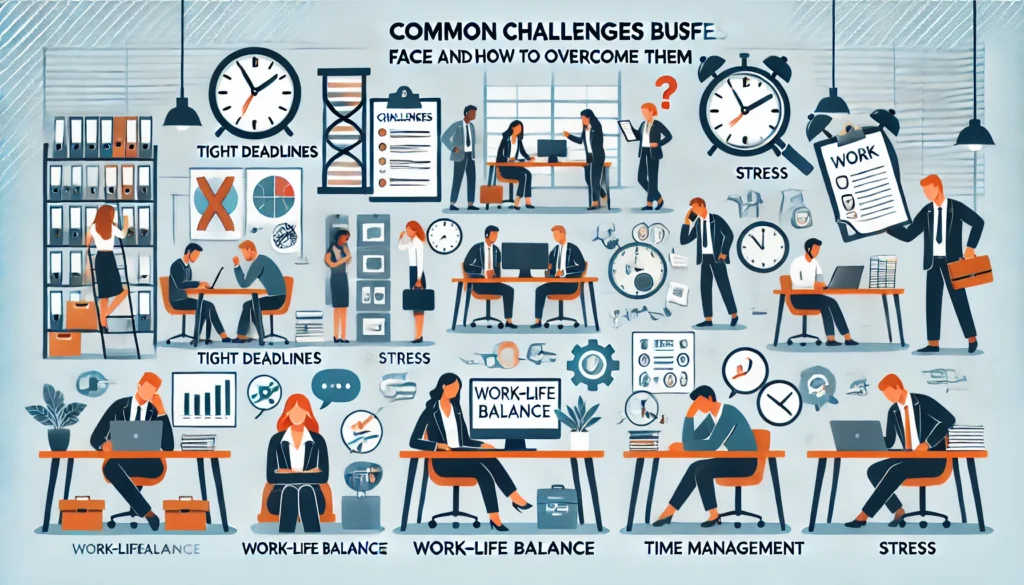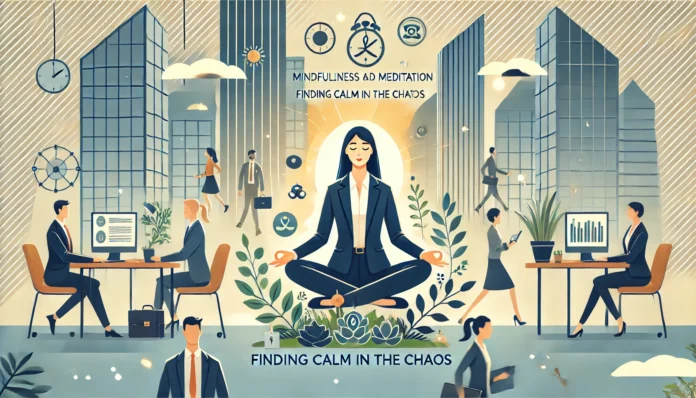Introduction
The busy lives of professionals are filled with a myriad of responsibilities, impending deadlines, and an overload of information. The continuous “on” mode can adversely affect our well-being, leading to stress, anxiety, and reduced productivity. What if there was a way to find calm in the chaos? Mindfulness and meditation practices offer powerful tools for busy professionals to achieve peace, improved focus, and better well-being.
This blog will help you understand how to incorporate mindfulness and meditation into your busy lifestyle. We’ll define what mindfulness is, explain its benefits for busy professionals, and give simple techniques that can easily fit into your day. You’ll get an overview of different meditation practices and resources that can help establish a sustainable, transformative practice.
The Juggling Act: Realities of a Busy Professional

Constant “On” Mode and Its Consequences on Well-being
Technology has kept us connected 24/7, blurring the edges between work and private life. Continuous mental stimulation leaves little space for relaxation and rejuvenation.
Symptoms of Stress and Information Overload
Constant pressure to perform and a deluge of information can lead to chronic stress, anxiety, burnout, poor concentration, and even somatic problems.
Why Busy Professionals Need Mindfulness and Meditation
Mindfulness and meditation offer a powerful antidote to stress and overwhelm common among busy professionals. They foster states of inner peace, enhance focus and clarity, and benefit well-being in general.
What is Mindfulness and How Does it Benefit Busy Professionals?
Mindfulness is the practice of purposefully orienting to whatever arises at the moment—without judgment. This means simply being aware of your thoughts, feelings, and bodily sensations without getting caught up in them or trying to control them.
The Science Behind Mindfulness: Its Effect on the Brain and Body
Substantial scientific evidence supports the benefits of mindfulness. Brain-imaging techniques have shown that mindfulness practices can:
- Reduce activation in the amygdala: This decreases stress hormones like cortisol, promoting relaxation and reducing anxiety.
- Increase activity in the prefrontal cortex: This enhances attention, focus, decision-making, and cognitive performance.
- Improve interconnections between brain regions: This helps regulate emotions better and respond to situations more calmly.
- Boost parasympathetic nervous system activity: This promotes the body’s “rest and digest” response, opposite to stress, cultivating relaxation and well-being.
How Busy Professionals Can Gain from Mindfulness: Less Stress, Sharper Focus, Greater Productivity
- Reduced Stress and Anxiety: By becoming aware of stress triggers and observing thoughts and emotions without judgment, you can manage stress more effectively.
- Better Concentration and Attention: Mindfulness trains your attention, making you less distracted and more focused.
- Better Productivity: Improved concentration leads to faster and more accurate work.
- Better Decision-Making: With a calmer and more composed mind, you can make better decisions.
- Greater Emotional Regulation: Understanding your feelings offers greater control over them, fostering better relationships and collaboration with coworkers.
Mindfulness helps you weather professional life with more serenity, clarity, and focus, promoting overall well-being and success.
Simple Mindfulness Exercises Anyone Can Fit into a Busy Schedule
Simple Mindfulness Exercises You Can Do Anywhere
The best thing about mindfulness is that it does not need any special equipment or place. Here are a few easy exercises that you can slip into your hectic schedule, anywhere and at any time:
The Mindful Minute: A Brief Breathing Meditation
- Find a quiet spot where you will not be disturbed. You can sit comfortably or stand erect.
- Gently shut your eyes, or if you prefer, soften your gaze.
- Bring your attention to your breath. Notice the sensation of your breath going in and out of your nostrils. Feel your chest and abdomen move up and down with each inhale and exhale.
- If your mind wanders, which is quite normal, don’t judge yourself. Just notice the thought and bring your attention gently back to your breath.
- Start with one minute and build up as you get more comfortable. Even a brief mindful breathing exercise can lower your stress levels and sharpen your concentration.
The Body Scan: Working with Physical Sensations
- Lie on your back or sit in a chair with your feet on the floor and your eyes closed or your gaze softened.
- Take a few deep breaths and bring attention to your body. Begin with your toes; wiggle them a little bit. Notice whatever sensations are there in your feet without judgment.
- Gradually go up through your body, paying attention to each part of it—your ankles, calves, knees, thighs, and so on. Bring into your awareness any feeling of tension, relaxation, warmth, or coolness.
- Continue the scan upwards, towards your torso, arms, hands, neck, head, and face. Note all sensations without judgment.
- When you have gone through every part of your body, breathe deeply a few more times and let yourself completely relax.
Mindful Eating: Relishing Every Bite
- First look at your food before eating it, noting the colors, textures, and smells.
- Slow down and take smaller bites. Chew well and notice flavors and sensations in your mouth.
- Notice what the food does as you swallow. Is it smooth, crunchy, sweet, or savory?
- Avoid distractions—like your phone or TV—during your meals. Notice the feeling of nourishing your body.
Putting Mindfulness into Your Everyday
It’s not only exercises that let you be more mindful, it’s about living all those moments in an aware state. Here are some ways to implement mindfulness into your daily routine:
The Power of the Pause: Taking Mindful Breaks Throughout the Day
- Set small mindfulness moments within your daily work schedule. Take a few minutes off, close your eyes, and breathe deeply.
- Use these breaks to unwind, refocus, and come back to your tasks with renewed vigor.
- Take mindful breaks during transitions, like from one meeting to another or before embarking on a new activity.
Mindful Communication: Active Listening and Focused Interactions
- Maintain mindful communication with colleagues. Pay attention to the speaker, push away the urge to multitask, and try putting yourself in the other person’s shoes.
- Ask questions for clarity, but never interrupt. It shows respect and helps you understand the information being passed.
- When you speak, be mindful of your tone of voice and nonverbal cues. Be careful with your words and be clear in all interactions.
With these daily practices, you can move toward personal and professional improvement by incorporating mindfulness. You will feel more composed, focused, and clear about your problems and their solutions.
Meditation: Deepening Your Mindfulness Practice
While mindfulness is the basic practice of attending to the moment, meditation is a technique aimed at obtaining a state of peace and focus. Here is how they are different:
- Mindfulness: Being aware of your thoughts, feelings, and bodily sensations without judgment, and practicing it throughout your day in any activity.
- Meditation: Training one’s mind by concentrating on an object, thought, or feeling. It is a set time to calm one’s mind and make it clear.
Think of mindfulness as the open sky, and meditation as one of many balloons floating in that sky. The sky is a metaphor for your general awareness, and the balloon, much like meditation, is focused attention.
Different Meditation Techniques to Help Busy Professionals
Meditation is diverse. Here are a few popular techniques for busy professionals:
Guided Meditations: Finding Audio Resources Online and in Apps
Guided meditations can be a great way to get started. In guided meditation, recordings walk you through the meditation process with instructions for focusing your breath, relaxing your body, and setting up calming scenes for visualization.
There are many free and paid guided meditations available online and through apps for goals such as stress reduction, better sleep, or improved focus.
Mantra Meditation: A Repetitive Chant for a Focused Mind
Mantra meditation involves the silent repetition of a word, phrase, or sound. The repetition quiets the mind and helps you focus. Choose a mantra that speaks to you, such as “Om” or the phrases “I am calm” or “Peace be with me,” and repeat it in your mind during meditation.
Walking Meditation: Putting Some Motion into Awareness
Walking meditation puts motion into mindfulness. Find a quiet space and walk back and forth at a slow pace, being mindful of the sensation of your feet touching the ground with each step. Notice the feeling of your body moving, the rhythm of your breath, and any sights or sounds you encounter. This can be helpful for those who cannot sit still for meditation.
Building a Sustainable Meditation Practice: Consistency is Key
The reward of meditation lies in consistency. A few minutes each day can make all the difference. Here are some tips to make it sustainable:
- Start Small: Begin with just 5-10 minutes a day and gradually increase the time as you get comfortable.
- Schedule Time: Treat meditation practice as any other essential appointment and put it on your calendar.
- Find a Quiet Space: Choose a quiet space with minimal distractions.
- Be Patient: Don’t give up if your mind wanders; it is normal. Notice where your mind went and gently refocus on your meditation.
- Keep Track of Your Progress: A meditation journal can help track progress and serve as motivation. Record any struggles or positive experiences during your practice.
By incorporating these tips and experimenting with different meditation practices, you’ll build a practice that helps you feel more tranquil, concentrated, and balanced in life.
Common Challenges Busy Professionals Face and How to Overcome Them

Squeezing Meditation into a Packed Schedule
Finding time to meditate can be challenging, but even a couple of minutes a day can make a big difference. Here are some strategies to fit meditation into your busy schedule:
- Use Micro-Meditations: Short meditations can be as effective as longer sessions. Practice 5-minute meditations throughout the day—before a significant meeting, during lunchtime, or before sleeping.
- The Power of Mornings: Even a small meditation session in the morning sets a positive tone for the day and enhances focus. It may even improve your well-being, even if it is as short as 10 minutes.
- Commuter Zen: If you take public transport to work, make this journey time a mindful meditation. Focus on your breath, observe your surroundings neutrally, or listen to a guided meditation.
- Turn Waiting Time into Mindful Waiting: Instead of reaching for your phone, take a few moments to meditate while waiting in line or stuck in traffic. Focus on your breath or do a simple body scan to help de-stress.
- Weekend Recharge: Set up longer meditation sessions during the weekends. This allows for a deeper dive and helps cement the practice.
Catching Distractions and a Wandering Mind
Your mind will wander. It’s supposed to. Here’s how to deal with distractions:
- Acknowledge and Release: When a thought crosses your mind, acknowledge it and gently bring your attention back to your point of focus—breath, mantra, or bodily sensations.
- Non-Judging Art: Don’t judge yourself for a wandering mind. It’s part of the process. The key is to bring your attention back gently, without frustration.
- Avoid External Distractions: Choose a quiet space to meditate, and consider using earplugs or white noise to block unwanted sounds.
Staying Motivated and Not Frustrated
Building a meditation practice takes time and effort. How do you stay motivated and avoid frustration?
- Focus on Progress, Not Perfection: Don’t expect instant enlightenment. Meditation is a journey, not a destination. Any progress, no matter how small, should be celebrated.
- Find a Meditation Community: Connect with others who meditate. Join a local meditation group or online forum to share experiences and ask questions.
- Track Your Journey: Keeping a meditation journal can help track progress and realize areas for improvement. Note down your challenges, positive experiences, and insights from your practice.
- Benefits Over Goals: Emphasize the positive results you’re experiencing, like reduced stress, improved focus, or better sleep. This will keep you motivated to continue the practice.
If you find one type of meditation too difficult, there are many others to try. Keep searching until you find the one that works for you.
Remember, it’s about consistency. Incorporate meditation into your daily routine—first in small bits—to build calmness, focus, and inner peace that carry over into life itself.
Resources for the Busy Professional: Apps, Online Courses, and Communities

Top Mindfulness and Meditation Apps for Busy Schedules
There are several apps available to help fit mindfulness and meditation into your busy schedule. Here are some popular ones:
- Headspace: Provides guided meditations and mindfulness exercises, with a variety of sleep sounds for various needs and experiences. Includes courses for beginners and short, bite-sized meditations.
- Calm: Features soothing visual elements and music, guided meditations, sleep stories narrated by celebrities, and breathing exercises for stress and anxiety. Also includes masterclasses on mindfulness by experts.
- Insight Timer: A free app with a vast collection of guided meditations contributed by a global community of teachers. Offers live meditation sessions and a timer for unguided practice.
- Aura: Provides personalized daily meditations tailored to your mood and goals, with sleep stories, music playlists, and gratitude journaling prompts.
- Simple Habit: Caters to busy schedules with short 5-minute guided meditations for focus, productivity, and stress relief.
Online Courses and Guided Meditations for Beginners
Online courses and guided meditations offer helpful structures for beginners in mindfulness and meditation. Here are some resources to explore:
- Mindfulness for Beginners by Sounds True: This online course provides a solid introduction to mindfulness practices with guided meditations, video lectures, and downloadable materials.
- UCLA Mindful Awareness Research Center: Offers many free resources on mindfulness meditation, including guided meditations, educational articles, and online courses.
- Mindfulness Project by Mindful.org: A free introductory course on mindfulness meditation that includes breathwork, body scan techniques, and mindful movement.
- Meditation Apps with Beginner Courses: Most of the mindfulness and meditation apps listed above, such as Headspace and Calm, offer courses for beginners to guide you through the basics of meditation practices.
Finding a Local Meditation Group and Community
Connecting with other meditators can be very motivational and help deepen your practice. Here’s how to find local meditation groups and communities:
- Meditation Apps and Websites: Many apps and websites list local meditation groups and centers in their directories.
- Local Yoga Studios and Wellness Centers: Many yoga studios and wellness centers offer meditation classes or can provide information on local meditation groups.
- Meetup: Use the Meetup website or app to find mindfulness and meditation groups in your area.
- Online Search: Search for “meditation groups near me” or “mindfulness communities” to find local resources.
Meditation groups and communities provide support, shared experiences, and the opportunity to work through group meditations. This relatedness and shared practice can be very fulfilling in the development of mindfulness and meditation.
Conclusion: Journey to a Calmer, More Focused You
Fast modern life leaves most of us overwhelmed, stressed out, and sometimes focus-challenged. But what if you found a way to develop inner peace, clarity, and boost your well-being amidst all the daily chaos? Mindfulness and meditation offer powerful tools for busy professionals to do just that.
By incorporating simple mindfulness exercises into your everyday activities, you will be more aware of the present moment, reducing stress while improving concentration and decision-making. Basic techniques to practice mindfulness include mindful breathing, body scan, and mindful eating—all easy to learn and fit into your daily routine, however tight your schedule may be.
Meditation furthers that by offering a focused domain where one learns to cultivate a state of peace and concentration. Whether you choose guided meditations, mantra repetitions, or walking meditation, there will be a method that fits your style. Remember, consistency is key. Even a few minutes every day can have a profound effect.
It’s a journey, not a destination. Embrace the challenges, celebrate the process, and take delight in the practice itself. Use resources like apps, online courses, and local communities for guidance and support on your way forward.
Equipping yourself with mindfulness and meditation will help you navigate life’s professional demands more calmly, clearly, and focused. Ultimately, this will lead to inner peace that spills over into all aspects of your life, allowing you to thrive both personally and professionally.
A Call to Action: Start Your Mindfulness and Meditation Journey Today
Experience the power of mindfulness and meditation today! Start right now by incorporating one easy mindfulness exercise from this blog into your daily routine. Download a meditation app or look for guided meditation techniques online that work best for you. Remember, even small changes can bring significant results.
Embrace the journey to a calmer, more focused you, and discover the benefits it can bring to your professional and personal life.


